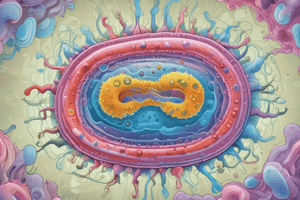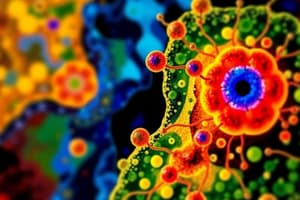Podcast
Questions and Answers
Which of the following organisms is a prokaryote?
Which of the following organisms is a prokaryote?
- A bacterium (correct)
- Seaweed
- A slime mold
- An amoeba
The important distinction between prokaryotes and eukaryotes is that prokaryotes ________ a nucleus, whereas the cells of eukaryotes ________ a nucleus.
The important distinction between prokaryotes and eukaryotes is that prokaryotes ________ a nucleus, whereas the cells of eukaryotes ________ a nucleus.
lack; have
____________ are organisms that live in extreme environments, such as hot springs.
____________ are organisms that live in extreme environments, such as hot springs.
- Protists
- Archaea (correct)
- Bacteria
- Slime molds
Eukaryotes are most closely related to which of the following prokaryotic groups?
Eukaryotes are most closely related to which of the following prokaryotic groups?
______________ evolved from _____________.
______________ evolved from _____________.
What is the term for spherical cell shape?
What is the term for spherical cell shape?
What is the term for rod cell shape?
What is the term for rod cell shape?
What is the term for spiral/corkscrew cell shape?
What is the term for spiral/corkscrew cell shape?
What characterizes a positive gram stain?
What characterizes a positive gram stain?
What characterizes a negative gram stain?
What characterizes a negative gram stain?
Negative gram stain may also have what?
Negative gram stain may also have what?
What is used for movement?
What is used for movement?
What is used for attachment?
What is used for attachment?
What are the producers of oxygen through photosynthesis?
What are the producers of oxygen through photosynthesis?
Which option lists a feature that is true of both Archaea and Eukarya?
Which option lists a feature that is true of both Archaea and Eukarya?
Archaea that assist in the digestion of cellulose are called _____.
Archaea that assist in the digestion of cellulose are called _____.
Disease-causing prokaryotes are called _____ and are _____.
Disease-causing prokaryotes are called _____ and are _____.
Peptic ulcers are caused by _____.
Peptic ulcers are caused by _____.
Several groups of protists have variable modes of nutrition: Some species are photoautotrophs, whereas close relatives are heterotrophs. Such diversity even exists within a single species in some cases. Evidence suggests that this pattern is a result of the __________.
Several groups of protists have variable modes of nutrition: Some species are photoautotrophs, whereas close relatives are heterotrophs. Such diversity even exists within a single species in some cases. Evidence suggests that this pattern is a result of the __________.
The newly defined protist group SAR consists of __________.
The newly defined protist group SAR consists of __________.
Amoebas move and feed by using _____.
Amoebas move and feed by using _____.
Flashcards are hidden until you start studying
Study Notes
Prokaryotes vs Eukaryotes
- Prokaryotes lack a nucleus; eukaryotes have a nucleus.
- Bacteria are examples of prokaryotes, while eukaryotes include organisms like seaweed and slime molds.
- Eukaryotes evolved from prokaryotes.
Archaea
- Archaea thrive in extreme environments, such as hot springs.
- They are closely related to eukaryotes, more than to bacteria.
- Methanogens are a type of archaea that assist in cellulose digestion and produce methane gas.
Cellular Shapes
- Cocci refer to spherical-shaped bacteria.
- Bacilli describe rod-shaped bacteria.
- Spirochetes are spiral or corkscrew-shaped bacteria.
Gram Staining
- A positive Gram stain indicates a thick layer of peptidoglycan.
- A negative Gram stain shows a thin peptidoglycan layer and may have a toxic outer membrane.
Cell Structures
- Flagella are structures used by some prokaryotes for movement.
- Fimbriae serve as attachment structures for prokaryotes.
Nutritional Modes
- Photoautotrophs use sunlight and CO2 for energy (e.g., cyanobacteria).
- Chemoautotrophs obtain energy from chemicals, also using CO2.
- Heterotrophs can be photoheterotrophs (using sunlight and organic compounds) or chemoheterotrophs (using chemicals and organic compounds).
Multicellular Algae Life Cycle
- Gametophyte is the multicellular form in a life cycle diagram.
- Spores are produced through meiosis and the sporophyte is the diploid stage post-fusion of gametes.
Prokaryote Importance
- Prokaryotes are highly abundant, crucial for ecological balance.
- E. coli, a bacilli-shaped bacterium, resides in human intestines.
- Prokaryote decomposers are essential in sewage treatment by removing organic waste.
Pathogens and Diseases
- Pathogens are disease-causing prokaryotes and account for many human diseases but are less significant than the beneficial roles prokaryotes play in ecosystems.
- H. pylori bacterium is responsible for peptic ulcers.
Protist Diversity
- Many protists showcase flexibility in nutrition, functioning as autotrophs or heterotrophs due to varied evolutionary adaptations, including endosymbiosis.
- The SAR group comprises both autotrophic algae and diverse heterotrophic protists.
Movement and Feeding
- Amoebas use pseudopods for movement and feeding, showcasing their flexible cellular structure.
Studying That Suits You
Use AI to generate personalized quizzes and flashcards to suit your learning preferences.




